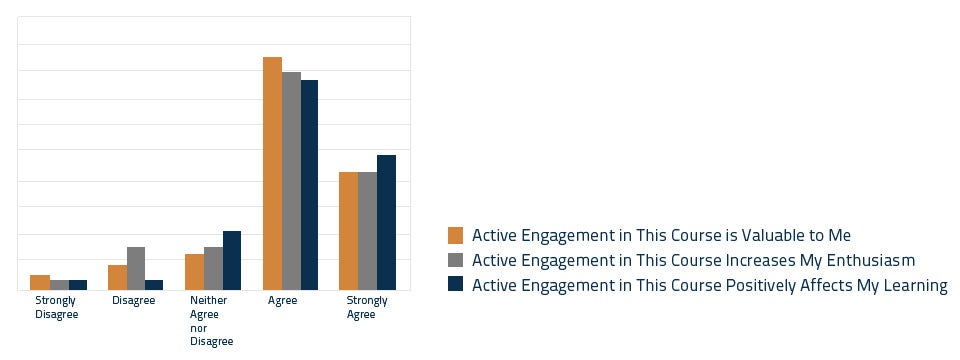Assessing the Active Learning Initiative at Case Western Reserve University
What impact does the implementation of active learning strategies and flexible, collaborative learning spaces have on students and faculty? As part of CWRU’s active learning initiative, four state-of-the-art collaborative learning spaces were developed. In addition, a faculty fellowship was designed to provide faculty with the resources need to (re)design a course using active learning techniques and integrate the affordances of the active learning spaces.
Our efforts employed an action-research approach with faculty deeply involved in the evaluation process, with some collecting their own data to present and publish as well as participating in the program-level assessment efforts. The results of each year’s results are intended to have an immediate impact on the design of new learning spaces (e.g., changes in learning space design from year one to year two), as well as the organization and support of the fellows and the learning spaces.
For the first year of the Active Learning Fellowship, as well as the first year using the new Active Learning Environments, the primary focus of the research was to evaluate how student and faculty perceptions of the newly designed courses differ with respect to:
- The types of instructional methods used in the courses
- The amount of active engagement throughout the course
- The type of classroom used (traditional vs. ALC)
Students in the first year of the fellowship reported relatively high levels of active engagement in their courses taught by Active Learning Fellows. Moreover, students reported an appreciation for this active engagement, as they conveyed that active learning in these courses 1) was valuable to them, 2) increased their enthusiasm for the course, and 3) positively affected their learning.
Student focus groups revealed themes that were consistent with these reports of active engagement. Some of these comments included:
Doing a class like this in just one format may get boring. Having so many different methodologies using these different technologies made it more interesting and informative. I need more going on than just PowerPoint. Using these different ways to learn is much more engaging.
This structure fits my generation much better. It’s more engaging, while also allowing for traditional teaching methods. This helps me learn better - it’s more hands on. More practical instruction - not just taught something but modeled it, too.
Active Learning Publications, Presentations & Grants
Publications
Juergensen, J., Oestreich, T., Yuhnke, B., Kenney, M. "New Challenges to Active Learning Initiatives" Educause Review. N.p., 25 Jan. 2016. Web.
Holmes, M., Tracy, E., Longs Painter, L., Oestreich, T., Park, H. Moving from flipcharts to the flipped classroom: Using technology driven teaching methods to promote active learning in foundation and advanced masters social work courses. Clinical Social Work Journal: Volume 43, Issue 2 (2015). 215-224. 3 February 2015.
Juergensen, J., Oestreich, T., Yuhnke, B., Kenney, M., Skapin, K., & Shapiro, W. "Active Learning at Case Western University." Educause Review. N.p., 26 January 2015.
Carter, J.L.W. & Yuhnke, B. "Active Learning Techniques and Online Tools Applied to the Educational Experience of 2nd Year Materials Science and Engineering Students" American Society for Engineering Education, June 2014.
Oestreich, T., Shapiro, W. & Yuhnke, B. "Case Study: Case Western Reserve University" AV/IT Infrastructure Guidelines for Higher Education, December 2014. 12,13
Presentations
Kenney, M., Oestreich, T., Shapiro, W. & Yuhnke, B. "Pedagogy Technology & Space." Ohio Higher Education Computing Conference, May 2014.
Oestreich, T., Shapiro, W. & Yuhnke, B. "Developing Partnerships Beyond the One Night Stand." New Media Consortium Summer Conference, June 2014.


